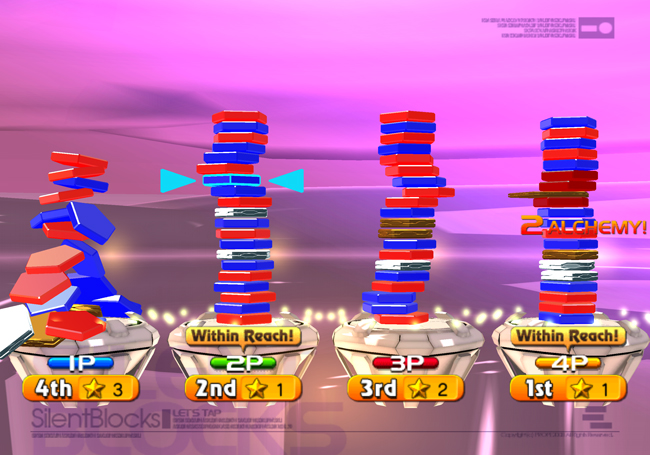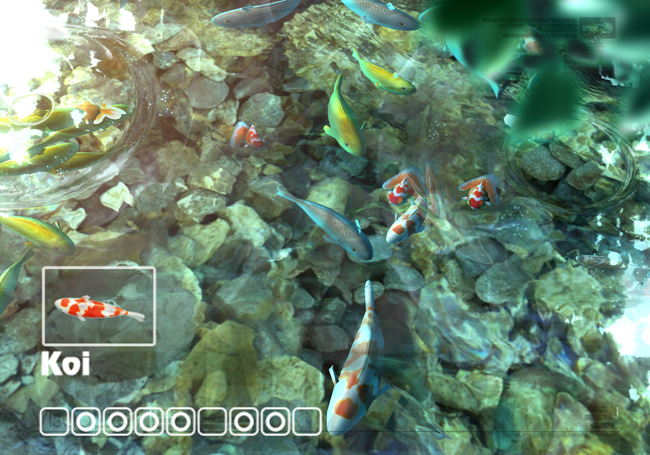When SEGA first announced that they were publishing Prope’s Let’s Tap, I think the initial thought that went through my head was “Wha—at?” Could a developer create such an ambitious, quirky title and actually make it fun, or would it amount to being a glorified tech demo?
SEGA was kind enough to send along a review copy for us to take a look at. Read on for our full review to help you decide if this is a game you’d want in your collection.
Let’s Tap is an interesting anomaly of a game. Think of it as being similar to Wii Play but with more interesting controls and mini games. Let’s Tap showcases the ability of the WiiMote to capture at least three levels of vibration strength. It threw me for a loop to know that the WiiMote had that much versatility, even without MotionPlus tacked on. The game is played by placing the WiiMote face down on a box, giving it a second to calibrate. Each controller needs to be on a separate box and preferably on as far apart on a table as possible, as the slightest inadvertent table bump or vibration can cause a player’s WiiMote to pick up the wrong signal. And DEFINITELY use a Wiimote jacket; I found my WiiMote bouncing around on the box without it. The optimal boxes to play on are cereal boxes. In my case, I used the cardboard box that SEGA shipped the game to me in.
Let’s Tap is the kind of game that is best played with 2-4 people. Although there is a single player mode, the game was designed with competition in mind. In fact, it’s the chaotic nature of having four players all tapping and slamming that interested me most. I chose to play the game with my wife, who instantly enjoyed her ability to beat me consistently. The game is designed to place competition on equal levels. No matter how good a player is at other mini-game collections, Let’s Tap‘s unique control scheme levels the playing field. I found myself often tapping too hard while my wife would play the levels and games perfectly, beating me with regularity. Her devilish smile hinted that she loved it. Yes, your wives will enjoy this game.
Tap Runner

The first of the 5 or 6 minigames we tried was Tap Runner, a Pitfall-like running game where characters run from left-to-right through and over obstacles trying to get to the goal. There are up to four runners on screen at once, with the game keeping track of finishes and offering medals at the end. The characters are simple, but designed well. They are essentially 3-D stick figures with a little bit of personality thrown in. The levels, on the other hand, are all too similar. The layout is of a transparent orange track amongst a black galactic background filled with different planets or moons, with little or no variation. That’s pretty much it.
Of all of the minigames, I found myself enjoying Tap Runner the most. Steady hands prevail, as consistent taps equal to running with double-taps causing jumps. I often found myself becoming a little too aggressive and over-tapping, causing my player to jump when I didn’t want him to. The obstacles — pits, black holes, spikes, trampolines, and swinging ropes, for example — offered a decent amount of variety to keep me from just tapping at the same speed for the length of the course.
Rhythm Tap
Rhythm Tap is a music-rhythm game, similar to Donkey Konga on the Gamecube. The game is laid out well, with a left-to-right motion of the music. Like Guitar Hero, circles are hit at the right time to award consecutive hit streaks. The visualizer was terrific, and the music moved at a great speed. Although the soundtrack was all new (sorry, no “Happy Birthday” for you!) it was catchy and interesting. There were times when the music and play track on screen seemed out of sync, but for the most part I enjoyed the play.
Silent Blocks

Silent Blocks is Jenga with a puzzle game twist. Based on how hard a player taps, the pieces are removed slowly or quickly. In “Alchemist” mode, as three colors are stacked they turn into a jewel. The jewels can also be stacked, allowing for creation (alchemy!) of new and higher-ranking jewels. Silent Blocks is probably the best of the multi-player minigames on the disc. Although simple in nature, the matches can last for quite a while amongst experience players; my wife and I had a match last for what seemed like 10-15 minutes.
Bubble Blaster
The two modes in Bubble Blaster are a side-scroller and an all-out battle field. In side-scrolling mode, the game play is simple: the character, a rocket-pack-endowed hero, floats up and down based on the strength and speed of taps. Double-tapping shoots a missle, and various obstacles can be destroyed. Hitting an obstacle damages the character, but health can be restored by grabbing life packs throughout the levels. There is a score kept in the game, but the actual goal is to advance as far as possible racking up level “length” in distance. The look of the game is very stylized: cell-shading and modern design make it seem as though the game was dreamed up by a graphic designer sniffing markers in a basement. I enjoyed playing this, and can see the main character becoming a new SEGA mainstay hero.
The battlefield mode wasn’t nearly as good to me. Up to four players can face off on screen. Their controllable characters rotate in place until the box is tapped, sending the rocketman in the last direction he was facing. Again, double-tapping fires missles but this time aiming for my adversary (in this case, my wife) was nearly impossible. I took a pass on this.
Visualizer

The visualizer mode is quite interesting. Playing this in the way that it is intended, by intentionally tapping to create images on the screen, is not fun. However, placing the WiiMote on a speaker as a CD player is jamming your favorite rendition of Billie Jean creates a terrific screen-saver. There are a few modes/stages within the visualizer, from a fish pond to a fireworks display to a few painting modes, that all contain a variety of secret visualizers within them. For instance, by tapping in a certain series in the pond, specific fish will appear and swim through. In the ink visualizer, different words and pictures are created. The stages can be played separately or by creating a playlist. I found myself placing the controller on several sound-emitting objects throughout the house. My sub-woofer created several cool images on screen. We even placed the controller on our fetal heart monitor to see what it would do. An interesting mode, albeit one that I won’t “play” moreso than leave on.
And Finally…
I’d have to say that I got a kick out of Let’s Tap. While not the kind of game I will play more than 10-15 minutes at a time, it is a nice addition to some of the more unique offerings on the Wii. As a collection of minigames, this is much better than WiiPlay. In fact if SEGA can somehow get a WiiMote included with this game as a package, they’d sell bucketloads. Billed as a budget game, $30 may still be a little too much to pay. Releasing the game as separate minigames for WiiWare could be a better way to go, or perhaps a sequel with more well known SEGA characters included — a Sonic racer would kick butt!
Minus a few issues Let’s Tap is a creative, fun game that could be a nice addition to a Wii owner’s collection… just don’t expect to play it for more than 15 minutes at a time. And DEFINITELY play it with friends in tow.


4 Comments